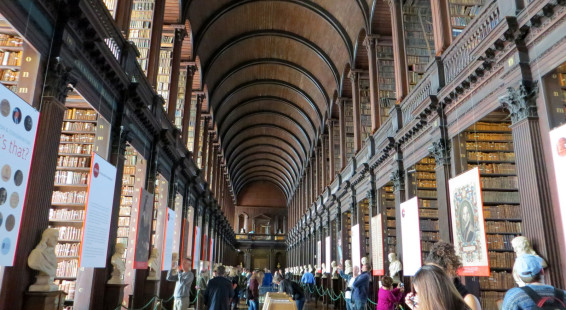
Trinity College gives you a grand entrance to its inner courtyard. Through a door within a massive larger door, you enter a square and see the college’s bell-tower (Campanile) set in its center, surrounded by an assortment of buildings. The Campanile is one of the College’s — for that matter Dublin’s — iconic landmarks; built in 1853, it stands 30.5 m (100 ft) tall and is mostly constructed of granite. You’ll not see students lingering under this tower because of a lasting superstition that if you’re beneath it when the bell tolls, you’ll fail your exams. But enjoy it’s fine construction then look around a bit.
Beyond the bell-tower, there’s a lot to see at Trinity College. Situated on the south bank of the River Liffey, the college was established by Queen Elizabeth I (to plant a seed or two or Protestant thought in this Catholic country). Originally only Protestant men were allowed to attend the College but women were finally admitted in 1903 and (while many had attended earlier), Catholics were formally allowed to study here in the 1970s. Trinity College is hands down the country’s most prestigious university.

Front Square of Trinity College, Dublin
An excellent way to be introduced to the college is with a 30 minute walking tour lead by senior students (tickets available just inside the main entry door). The student guides have to wear traditional brown “student cloaks” and, as one would expect from the Irish, these guides are articulate, witty, and lead an entertaining tour. Of course you have the option of exploring the grounds of the College on your own.
The walking tour takes you around most of the buildings in Front Square, past some of the dormitories (shared by both students and faculty), and on to modern Berkeley Library. Included with your tour fee is paid admission to see the Book of Kells and the Old Library, the gems of the college, which is where the walking tour ends.
One of the most fascinating things I saw in Ireland — and there were many — was the Book of Kells. Your admission takes you into a museum where you’ll want to spend at least an hour exploring all the exhibits. The introductory exhibits give you a historic backdrop to the 8th century when these books were crafted. Few people realize that writing and reading were mostly lost on the European continent during this time, but fortunately survived in the small monasteries in the furthest places of the known world (which was Ireland at that time); we owe these monks a great deal for saving so much knowledge.
I especially enjoyed a video which demonstrated the process and hundreds of hours of careful work required in manually creating these books. Written on vellum (calf leather), the Book of Kells represents the four Gospels (each as a separate volume). Painstakingly monks transcribed these gospels and illustrated them, then bound them into the books you can still see today. Inks used by the monks were colored by pigments from minerals and plants. Besides written text, the Books contain numerous illustrations of the life of Christ. These four gospels were created on the island of Iona, Scotland, but taken inland around the late 8th century to the Irish monastery at Kells to protect them from Viking raiders who repeatedly ravaged coastal Ireland.
Your visit to the Book of Kells exhibit ends in the Treasury where you have a chance to actually see about 10 historic manuscripts and books, including two of the four volumes of the Book of Kells (under glass in a room of low light — no photos allowed). One book is open to text and the other will be open to a lovely illustration. They are truly beautiful creations — hard to believe they’re over 1200 years old! Some have described the Book of Kells as the finest piece of art from the Dark Ages and when you see them in person, you’ll understand why this seems a reasonable claim.

Sample of the Book of Kells, Trinity College, Dublin
After you’ve completed your visit to the Book of Kells you ascend to the Old Library — a beautiful long wood paneled room containing 200,000 of the library’s rarest/oldest books stacked ceiling to floor, sort of like the “Beast’s” library in the Disney cartoon of “Beauty and the Beast”.
The library is a striking site by itself, but you’ll also have the chance to see some additional old manuscripts and two special items:
- The beautiful Brian Boru Harp. Dating to the 15th century, it is the oldest known harp in Ireland. A national symbol, you’ll see it on the back of your Irish Euro coins. Around the time of Queen Elizabeth I, harpists were killed and their instruments destroyed in an effort to kill the musical heritage of the Irish and pacify the people.

15th century Brian Boru Harp, Trinity College Library
- An original copy of the Proclamation of the Irish Republic. Read by Patrick Pearse outside the General Post office in 1916, it lead to the Easter Uprising culminating in Irish Independence. Everyone who signed the Proclamation was executed by the British. Only a few copies of this document survive.
So to summarize, I’d consider a visit to Trinity College a “must see” while in Dublin. The entire visit will take about a half day to complete. It’s best to visit the Book of Kells very early or later in the day as the lines can get quite long when the tour buses start rolling by.
(Click on thumbnails to enlarge, then right arrow to advance the slideshow)


































4 Responses to Dublin, Ireland: Trinity College and its Book of Kells